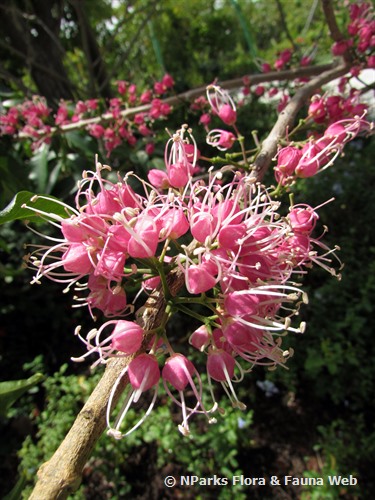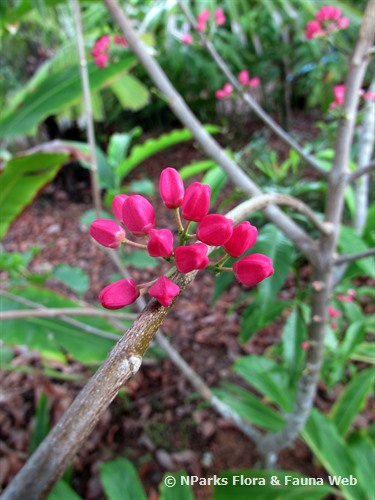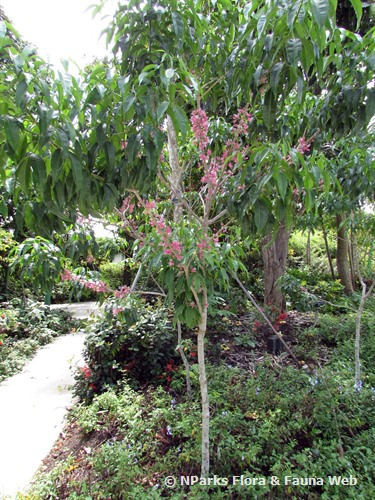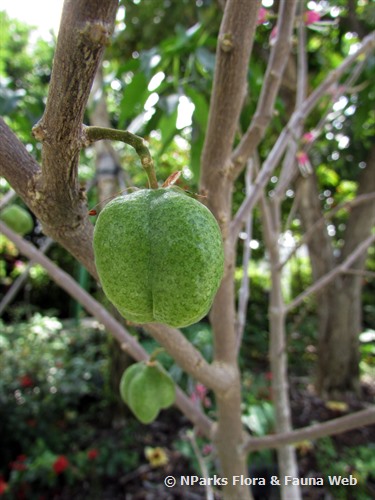
Name
Classifications and Characteristics
| Plant Division | Angiosperms (Flowering Seed Plants) (Dicotyledon) |
|---|---|
| Plant Growth Form | Shrub |
| Lifespan (in Singapore) | Perennial |
| Mode of Nutrition | Autotrophic |
Biogeography
| Native Habitat | Terrestrial |
|---|---|
| Preferred Climate Zone | Sub-Tropical / Monsoonal |
Description and Ethnobotany
| Growth Form | A large shrub which can grow to a small tree, up to 4 m tall. It can flowers and fruits as a shrub. |
|---|---|
| Trunk | Grey bark. |
| Foliage | Its leaves are compound trifoliate (consisting of 3 leaflets), glossy green in colour, measuring up to 7.5 cm long. Leaflets produce an aromatic odour when crushed. Midveins are raised on the upper surface of leaves. |
| Flowers | Clusters of pink flowers, produced on the branches. The 4 petals are glabrous on the outer surface while hairy on the inner surface. |
| Fruit | Green to yellowish citrus-like fruits, grows to about 4 cm in diameter. Fruit surface is fleshy and rugose due to large oil glands. Fruits will split open at the top to release black seeds. Seeds are about 5 mm. |
| Habitat | Found on the margins of seasonal rainforests, lowland and highland forests. |
| Cultivation | Propagation is best with fresh seeds. Plant would benefit from soil with added organic material. |
| Etymology | The genus Melicope is from Greek, mel means honey/nectar and kope means notched, in reference to the notched glands on the flowers. The specific epithet rubra means red or ruddy, referring to the flower colours. The old synonym of this plant is Evodiella means Little Evodia which common name applies to all Melicope genus. |
Landscaping Features
| Desirable Plant Features | Ornamental Flowers |
|---|---|
| Landscape Uses | Parks & Gardens |
Fauna, Pollination and Dispersal
| Fauna Pollination Dispersal Associated Fauna | Bird-Attracting (Fruits), Butterfly-Attracting (Flower Nectar) |
|---|
Plant Care and Propagation
| Light Preference | Semi-Shade, Full Sun |
|---|---|
| Water Preference | Moderate Water |
| Rootzone Tolerance | Moist Soils, Well-Drained Soils, Fertile Loamy Soils |
| Potential Problems | No potential pests found. |
| Propagation Method | Seed |
Foliar
| Foliage Retention | Evergreen |
|---|---|
| Mature Foliage Colour(s) | Green |
| Mature Foliage Texture(s) | Glossy / Shiny |
| Prominent Young Flush Colour(s) | Green |
| Young Flush Texture(s) | Glossy / Shiny |
| Foliar Type | Compound (Trifoliate) |
| Foliar Arrangement Along Stem | Opposite |
| Foliar Attachment to Stem | Petiolate |
| Foliar Shape(s) | Non-Palm Foliage |
| Foliar Venation | Pinnate / Net |
| Foliar Margin | Entire |
Floral (Angiosperm)
| Flower Colour(s) | Pink |
|---|---|
| Flower Texture(s) | Smooth |
| Flower Grouping | Cluster / Inflorescence |
| Flower Location | Cauliflorous |
| Flower Symmetry | Radial |
| Flowering Period | Free-Flowering |
Fruit, Seed and Spore
| Mature Fruit Colour(s) | Yellow / Golden |
|---|---|
| Mature Fruit Texture(s) | Rough |
Image Repository
Others
| Master ID | 33088 |
|---|---|
| Species ID | 7502 |
| Flora Disclaimer | The information in this website has been compiled from reliable sources, such as reference works on medicinal plants. It is not a substitute for medical advice or treatment and NParks does not purport to provide any medical advice. Readers should always consult his/her physician before using or consuming a plant for medicinal purposes. |






